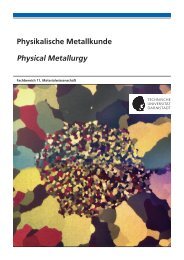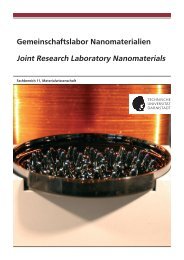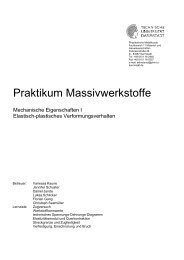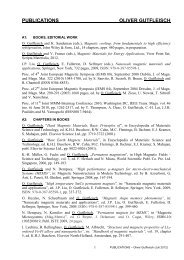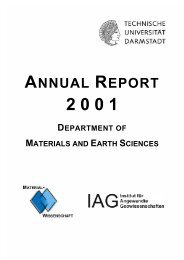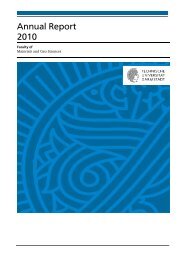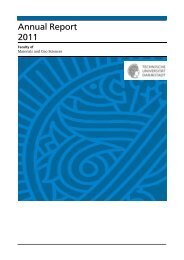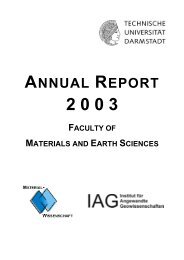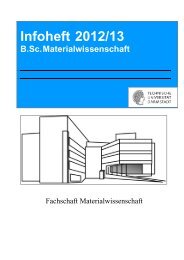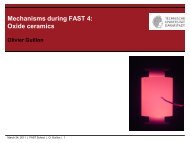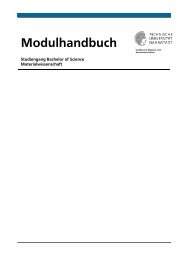mechanisms of sintering
mechanisms of sintering
mechanisms of sintering
Create successful ePaper yourself
Turn your PDF publications into a flip-book with our unique Google optimized e-Paper software.
BASIC MECHANISMS INVOLVED IN FAST SINTERING<br />
Umberto U be oAnselmi‐Tamburini se a bu<br />
Department <strong>of</strong> Chemistry<br />
University <strong>of</strong> Pavia<br />
Italy
MECHANISMS OF SINTERING<br />
Sintering requires mass transfer through diffusion<br />
The mechanism <strong>of</strong> mass transfer depends on the material, the experimental<br />
conditions, and the <strong>sintering</strong> stage<br />
Umberto Anselmi‐Tamburini Basic <strong>mechanisms</strong> involved in FAST <strong>sintering</strong>
MECHANISMS OF SINTERING<br />
W.D.Kingery, H.K.Bowen, D.R.Uhlmann, Introduction to ceramics , Wiley<br />
Umberto Anselmi‐Tamburini Basic <strong>mechanisms</strong> involved in FAST <strong>sintering</strong>
MECHANISMS OF SINTERING<br />
W.D.Kingery, H.K.Bowen, D.R.Uhlmann, Introduction to ceramics , Wiley<br />
Umberto Anselmi‐Tamburini Basic <strong>mechanisms</strong> involved in FAST <strong>sintering</strong>
MECHANISMS IN FAST SINTERING<br />
• FAST <strong>sintering</strong> g involves experimental p conditions more complex p than in<br />
traditional <strong>sintering</strong>, so more mass transfer <strong>mechanisms</strong> might be involved<br />
• The number <strong>of</strong> involved <strong>mechanisms</strong> and their relative relevance is still being<br />
debated<br />
• It is very dependent on the material physical and chemical properties and on<br />
the experimental conditions<br />
Umberto Anselmi‐Tamburini Basic <strong>mechanisms</strong> involved in FAST <strong>sintering</strong>
MECHANISMS IN FAST SINTERING<br />
•Arc and spark discharge<br />
•Electromigration<br />
•Electric field induced diffusion<br />
•Temperature gradients<br />
•Pressure and stress gradient<br />
•Modification <strong>of</strong> defects concentration<br />
•Heating rate<br />
Umberto Anselmi‐Tamburini Basic <strong>mechanisms</strong> involved in FAST <strong>sintering</strong>
MECHANISMS IN FAST SINTERING<br />
•Arc and spark discharge<br />
•Electromigration<br />
•Electric field induced diffusion<br />
•Temperature gradients<br />
•Pressure and stress gradient<br />
•Modification <strong>of</strong> defects concentration<br />
•Heating rate<br />
Umberto Anselmi‐Tamburini Basic <strong>mechanisms</strong> involved in FAST <strong>sintering</strong>
MECHANISMS IN FAST SINTERING<br />
M.Tokita, Proc. NEDO Int. Symp. Functionally Graded Materials, Kyoto, Japan, 1999<br />
Umberto Anselmi‐Tamburini Basic <strong>mechanisms</strong> involved in FAST <strong>sintering</strong>
ARC AND SPARK DISCHARGE<br />
M.Tokita, Proc. NEDO Int. Symp. Functionally Graded Materials, Kyoto, Japan, 1999<br />
Umberto Anselmi‐Tamburini Basic <strong>mechanisms</strong> involved in FAST <strong>sintering</strong>
ARC AND SPARK DISCHARGE<br />
• Arc discharge<br />
hi high h current t (>10 A) and d llow voltage lt (< 20 V)<br />
•Spark discharge<br />
transient very high current (kA) and voltage (kV/cm)<br />
•Glow discharge<br />
low current (< 1A) and relatively high voltage (300 V)<br />
Umberto Anselmi‐Tamburini Basic <strong>mechanisms</strong> involved in FAST <strong>sintering</strong>
What is the voltage that the sample<br />
experience p in a FAST apparatus? pp<br />
ARC AND SPARK DISCHARGE<br />
U. Anselmi-Tamburini, S. Gennari, J.E. Garay, Z.A. Munir, Mat. Sci. Eng. A 394 (2005) 139–148<br />
Umberto Anselmi‐Tamburini Basic <strong>mechanisms</strong> involved in FAST <strong>sintering</strong>
ARC AND SPARK DISCHARGE<br />
The imposed fields are just few volts, but polarization<br />
effects can produce localized fields order <strong>of</strong> magnitude<br />
higher<br />
Umberto Anselmi‐Tamburini Basic <strong>mechanisms</strong> involved in FAST <strong>sintering</strong>
Evidences supporting the presence <strong>of</strong><br />
discarges g<br />
SEM image <strong>of</strong> polyethylene fiber.<br />
ARC AND SPARK DISCHARGE<br />
Electric discharge pattern on the surface <strong>of</strong><br />
CeSiNO2.<br />
SEM image <strong>of</strong> the polyethylene fiber exposed<br />
to electrical discharge in air.<br />
M. Omori : Materials Science and Engineering A287 (2000) 183–188<br />
Umberto Anselmi‐Tamburini Basic <strong>mechanisms</strong> involved in FAST <strong>sintering</strong>
ARC AND SPARK DISCHARGE<br />
Evidences supporting the presence <strong>of</strong> discarges<br />
O. Yanagisawa et al. / Materials Science and Engineering A350 (2003) 184/189<br />
Umberto Anselmi‐Tamburini Basic <strong>mechanisms</strong> involved in FAST <strong>sintering</strong>
Evidences against the presence <strong>of</strong> discarges<br />
ARC AND SPARK DISCHARGE<br />
D.M. Hulbert, A. Anders, D. V. Dudina, J. Andersson, D. Jiang, C. Unuvar, U. Anselmi-Tamburini, E. J. Lavernia, and A.K. Mukherjee, J. Appl. Phys. 104 (2008) 033305<br />
Umberto Anselmi‐Tamburini Basic <strong>mechanisms</strong> involved in FAST <strong>sintering</strong>
Evidences against the presence <strong>of</strong> discarges<br />
ARC AND SPARK DISCHARGE<br />
A FFT plot <strong>of</strong> one duty cycle <strong>of</strong> the SPS process. This<br />
plot is for the SPS <strong>of</strong> 325 mesh 99.9% pure Al powder after a temperature <strong>of</strong><br />
100 °C was reached using a heating rate <strong>of</strong> 100 °C/min.<br />
D.M. Hulbert, A. Anders, D. V. Dudina, J. Andersson, D. Jiang, C. Unuvar, U. Anselmi-Tamburini, E. J. Lavernia, and A.K. Mukherjee, J. Appl. Phys. 104 (2008) 033305<br />
Umberto Anselmi‐Tamburini Basic <strong>mechanisms</strong> involved in FAST <strong>sintering</strong>
MECHANISMS IN FAST SINTERING<br />
•Arc and spark discharge<br />
•Electromigration<br />
•Electric field induced diffusion<br />
•Temperature gradients<br />
•Pressure and stress gradient<br />
•Modification <strong>of</strong> defects concentration<br />
•Heating rate<br />
Umberto Anselmi‐Tamburini Basic <strong>mechanisms</strong> involved in FAST <strong>sintering</strong>
DIFFUSION AND EXTERNAL DRIVING FORCES<br />
J<br />
∂C<br />
= −D<br />
+ v~<br />
C<br />
∂ x<br />
u is the mobility<br />
v ~ = uFF<br />
F the driving force<br />
H.Mehrer , Diffusion in solids, Springer<br />
Umberto Anselmi‐Tamburini Basic <strong>mechanisms</strong> involved in FAST <strong>sintering</strong>
ELECTROMIGRATION<br />
• Correlation between ionic and electronic conduction.<br />
• Usually observed in metals for current densities > 1000 A/cm 2<br />
• Huge importance in semiconductor industry<br />
Umberto Anselmi‐Tamburini Basic <strong>mechanisms</strong> involved in FAST <strong>sintering</strong>
For electromigration:<br />
∂C<br />
J = −D<br />
+ uFC<br />
∂x<br />
F =<br />
=<br />
*<br />
e Z E<br />
e ( e w<br />
Z + Z )E<br />
ELECTROMIGRATION<br />
If the mobility is given by the Nernst‐Einstein equation :<br />
J<br />
∂C<br />
DC *<br />
= −D<br />
+ Z e E<br />
∂x<br />
kt<br />
∂C<br />
DC *<br />
= −D<br />
+ Z e ρ j<br />
∂ ∂x<br />
kt<br />
Z e electrostatic interaction<br />
Z w “wind effect”<br />
u =<br />
D<br />
kT<br />
Vacancy diffusion in metals<br />
D.G. Pierce and P. G. Brusius,, Microelectron. Reliab., Vol. 37, No. 7, pp. 1053 -1072, 1997<br />
Umberto Anselmi‐Tamburini Basic <strong>mechanisms</strong> involved in FAST <strong>sintering</strong>
ELECTROMIGRATION<br />
How much much current flows through the sample in a FAST system?<br />
U. Anselmi-Tamburini, S. Gennari, J.E. Garay, Z.A. Munir, Materials Science and Engineering A 394 (2005) 139–148<br />
Umberto Anselmi‐Tamburini Basic <strong>mechanisms</strong> involved in FAST <strong>sintering</strong>
900 ° °C<br />
60 min<br />
a) 0 A<br />
b) 700 A<br />
c) 850 A<br />
d) 1040 A.<br />
ELECTROMIGRATION AND SINTERING<br />
Copper spheres on Copper plate<br />
J.M. Frei, U.Anselmi-Tamburini, Z.A. Munir, J. Appl. Phys. 101 (2007) 114914<br />
Umberto Anselmi‐Tamburini Basic <strong>mechanisms</strong> involved in FAST <strong>sintering</strong>
*<br />
Z l b<br />
ELECTROMIGRATION AND GRAIN BOUNDARIES<br />
1<br />
J l = N l lD<br />
l j jρρ<br />
eZ<br />
kT<br />
1 Nbδ<br />
J b = j jρρ<br />
eZ<br />
kkT<br />
d<br />
*<br />
l<br />
*<br />
b<br />
J l<br />
Jb b b b<br />
*<br />
l N l δ D l Zl<br />
=<br />
j jρe<br />
*<br />
N d D Z<br />
δ bboundary d width id h<br />
d grain size<br />
*<br />
and Z do not differ by more than an order <strong>of</strong> magnitude, so for Al with d=1μm d 1μm and 0.5 T Tm: m:<br />
Z<br />
Nl δ<br />
≅ 1 ≅ 10<br />
N d<br />
b<br />
3<br />
D<br />
D<br />
l<br />
b<br />
≅ 10<br />
−7<br />
J<br />
J<br />
l<br />
b<br />
≅ 10<br />
−4<br />
P.S.Ho and T.Kwok, Rep.Prog.Phys., 52 (1989) 301<br />
Umberto Anselmi‐Tamburini Basic <strong>mechanisms</strong> involved in FAST <strong>sintering</strong>
Al<br />
Au<br />
Al<br />
ELECTROMIGRATION AND REACTIVITY<br />
Formation <strong>of</strong> intermetallic compounds<br />
The enhancement depends on the intrinsic<br />
diffusivity and on the magnitude <strong>of</strong> the<br />
electromigration on the various species<br />
A general phenomenologial model has been<br />
developed by C.‐M. Hsu, D. S.‐H. Wong, S.‐W‐<br />
Chen, h J.Appl.Phys., l h 102 ( (2007) ) 023715<br />
N.Bertolino, J.Garay, U.Anselmi-Tamburini, Z.A.Munir, Phil.Mag.B, 82 (2002) 969<br />
Umberto Anselmi‐Tamburini Basic <strong>mechanisms</strong> involved in FAST <strong>sintering</strong>
ELECTROMIGRATION IN SOLID-LIQUID REACTIVITY<br />
Formation <strong>of</strong> intermetallic compounds<br />
767°C 767 C , 15 min<br />
(a) 0 A/cm2 (b) 316 A/cm2 (c) 474 A/cm2 (c) 474 A/cm<br />
(d) 585 A/cm2 J.F. Zhao, C. Unuvar, U. Anselmi-Tamburini, Z.A. Munir , Acta Materialia 55 (2007) 5592–5600<br />
Umberto Anselmi‐Tamburini Basic <strong>mechanisms</strong> involved in FAST <strong>sintering</strong>
MECHANISMS IN FAST SINTERING<br />
•Arc and spark discharge<br />
•Electromigration<br />
•Electric field induced diffusion<br />
•Temperature gradients<br />
•Pressure and stress gradient<br />
•Modification <strong>of</strong> defects concentration<br />
•Heating rate<br />
Umberto Anselmi‐Tamburini Basic <strong>mechanisms</strong> involved in FAST <strong>sintering</strong>
FIELD INDUCED DIFFUSION IN IONIC MATERIALS<br />
Diffusion under the influence <strong>of</strong> an external driving force<br />
v ~ = uF<br />
u is the mobilityy<br />
F is the driving force<br />
∂C<br />
J = − D + v~<br />
C<br />
∂x<br />
In a ionic crystal the electric field produce a flux <strong>of</strong> material<br />
F =<br />
qE<br />
j<br />
qCD<br />
vC<br />
E<br />
kT<br />
~ =<br />
je 2<br />
q CD<br />
q j = E<br />
kT<br />
je = σ E<br />
2<br />
q CD<br />
σ =<br />
kT<br />
= Material flux<br />
= Electric current<br />
u =<br />
Umberto Anselmi‐Tamburini Basic <strong>mechanisms</strong> involved in FAST <strong>sintering</strong><br />
D<br />
kT
FIELD INDUCED DIFFUSION IN IONIC MATERIALS<br />
• In ionic materials conduction is related to the<br />
df defectsconcentration t t ti and d mobility. bilit<br />
• Ionic and electronic defects concentrations<br />
are controlled by complex equilibria<br />
• Purely ionic conductors<br />
• Mixed conductors<br />
When ionic conduction is associated to trasfer<br />
<strong>of</strong> material there is the possibility <strong>of</strong> field<br />
induced <strong>sintering</strong> or densification<br />
Umberto Anselmi‐Tamburini Basic <strong>mechanisms</strong> involved in FAST <strong>sintering</strong>
FIELD INDUCED DIFFUSION IN IONIC MATERIALS<br />
Four kind <strong>of</strong> electrodes<br />
Crystal<br />
(-)<br />
(+)<br />
Cathode Anode<br />
•Reversible to electrons and ions<br />
•Semi‐blocking bl k ionic ( passing only l ionic current) )<br />
•Semi‐blocking electronic ( passing only electronic current)<br />
•Blocking (passing neither ionic nor electronic currents) – non contact field<br />
Umberto Anselmi‐Tamburini Basic <strong>mechanisms</strong> involved in FAST <strong>sintering</strong>
FIELD INDUCED DIFFUSION IN IONIC MATERIALS<br />
Mixed conductor – identical reversible electrodes<br />
a<br />
b<br />
M<br />
M<br />
Z1<br />
( + ) ( s ) → M + Z e'<br />
( M )<br />
1<br />
b<br />
Z2<br />
( −)<br />
() s + X → M X + Z e'(<br />
M )<br />
1<br />
a<br />
b<br />
2<br />
S.C. Byeon, K.S. Hong, Mat.Sci.Eng., A287 (2000) 159-170<br />
Umberto Anselmi‐Tamburini Basic <strong>mechanisms</strong> involved in FAST <strong>sintering</strong>
FIELD INDUCED DIFFUSION IN IONIC MATERIALS<br />
Mixed conductor – reversible identical gas electrodes<br />
Umberto Anselmi‐Tamburini<br />
1<br />
a<br />
M<br />
a<br />
X<br />
b<br />
X Z<br />
→<br />
b<br />
2a<br />
X<br />
1<br />
2<br />
2<br />
Z1<br />
( + ) ( g)<br />
+ M + Z e'(<br />
Pt)<br />
( −)<br />
→ X ( g)<br />
Z e'(<br />
Pt)<br />
2 +<br />
2<br />
2<br />
1<br />
S.C. Byeon, K.S. Hong, Mat.Sci. Eng., A287 (2000) 159-170
FIELD INDUCED DIFFUSION IN IONIC MATERIALS<br />
Tubandt electrotransport experiment<br />
C.-S.Kim, H.-I.Yoo, J.Electrochem.Soc., 143 (1996) 2863<br />
Umberto Anselmi‐Tamburini Basic <strong>mechanisms</strong> involved in FAST <strong>sintering</strong>
FIELD INDUCED DIFFUSION IN IONIC MATERIALS<br />
Electrotransport and <strong>sintering</strong><br />
S.C. Byeon, K.S. Hong, Mat.Sci. Eng., A287 (2000) 159-170<br />
Umberto Anselmi‐Tamburini Basic <strong>mechanisms</strong> involved in FAST <strong>sintering</strong>
FIELD INDUCED DIFFUSION IN IONIC MATERIALS<br />
Electrotransport and <strong>sintering</strong> – jouining single crystals <strong>of</strong> ferrite<br />
()900°C (a) 900°C, 12 hh, no current<br />
1200°C for: f<br />
(b) 900°C, 12 h, 1 A<br />
(a) 3 h, 1 A<br />
(c) 1100°C, 12 h, no current<br />
(b) 6 h, 1 A<br />
(d) ( ) 1100°C, , 12h, , 1 A (c) () 12 h, , 1 A<br />
(d) 24 h, 1 A<br />
S.C. Byeon, K.S. Hong, Mat.Sci. Eng., A287 (2000) 159-170<br />
Umberto Anselmi‐Tamburini Basic <strong>mechanisms</strong> involved in FAST <strong>sintering</strong>
FIELD INDUCED DIFFUSION IN IONIC MATERIALS<br />
Grain boundary migration in alumina<br />
J.-W.Jeong, J.-H.Han, D.-Y.Kim,, J. Am. Ceram. Soc., 83 (2000) 915–18<br />
Umberto Anselmi‐Tamburini Basic <strong>mechanisms</strong> involved in FAST <strong>sintering</strong>
1350°C<br />
12 min<br />
100 V<br />
1350°C<br />
12 min<br />
0 V<br />
FIELD INDUCED DIFFUSION IN IONIC MATERIALS<br />
Solid state reaction (reactive <strong>sintering</strong>)<br />
(1)MgO<br />
(2) MgIn 2O 4<br />
(3) In 2O 3<br />
(4) Pt cathode<br />
C. Korte, N. Ravishankar, C.B. Carter , H. Schmalzried, Solid State Ionics 148 (2002) 111 –121<br />
Umberto Anselmi‐Tamburini Basic <strong>mechanisms</strong> involved in FAST <strong>sintering</strong>
FIELD INDUCED DIFFUSION IN IONIC MATERIALS<br />
Solid state reaction (reactive <strong>sintering</strong>)<br />
• If the h iionic i current iis di directed d towards d B B2OO 3, the h total l growth h rate is i increased. i d During D i its i growth h the h<br />
spinel layer shifts towards the cathode.<br />
• If the ionic current is directed towards AO, the growth process ends in a steady state with a constant<br />
thickness. The steady y state derive from the compensation p <strong>of</strong> the electric and the chemical driving g forces.<br />
C. Korte, N. D. Zakharov and D. Hesse, Phys. Chem. Chem. Phys., 2003, 5, 5530–5535<br />
Umberto Anselmi‐Tamburini Basic <strong>mechanisms</strong> involved in FAST <strong>sintering</strong>
FIELD INDUCED DIFFUSION IN IONIC MATERIALS<br />
Cross Cross‐correlation correlation between electronic and ionc conduction<br />
In mixed ionic electronic conductors a flux <strong>of</strong> mobile ions might be induced not only by a<br />
gradient <strong>of</strong> its own electrochemical potential potential, but also, also indirectly, indirectly by a gradient <strong>of</strong><br />
electrochemical potential <strong>of</strong> electrons<br />
⎛ i ⎞ ⎛ Lii<br />
Lie<br />
⎞⎛<br />
∇ i ⎞<br />
⎜<br />
⎟<br />
⎜<br />
⎟<br />
⎜<br />
⎟<br />
⎝ ⎠ ∇<br />
⎜<br />
⎟ = − ⎜<br />
⎟<br />
⎝ J e ⎠ ⎝ Lei<br />
Lee<br />
⎠ ηe<br />
J η ie ei<br />
usually it is considered L L = 0<br />
ie<br />
= ei<br />
In some semicondacting oxides this<br />
assumption is not valid. This can<br />
produce a transfer <strong>of</strong> matter in<br />
presence <strong>of</strong> intense electronic fluxes<br />
L = L Onsager relationship<br />
meaning that ions and electrons mo move e<br />
independently<br />
H.-I. Yoo, D.-K. Lee, Solid State Ionics 179 (2008) 837–841<br />
Umberto Anselmi‐Tamburini Basic <strong>mechanisms</strong> involved in FAST <strong>sintering</strong>
FIELD INDUCED DIFFUSION IN IONIC MATERIALS<br />
Cross Cross‐correlation correlation between electronic and ionc conduction<br />
α<br />
α<br />
*<br />
i<br />
*<br />
e<br />
=<br />
=<br />
L<br />
L<br />
L<br />
L<br />
ei<br />
ii<br />
ie<br />
ee<br />
⎛ J<br />
=<br />
⎜<br />
⎝ J<br />
e<br />
⎛ J<br />
=<br />
⎜<br />
⎝ J<br />
i<br />
i<br />
e<br />
⎞<br />
⎟<br />
⎠<br />
⎞<br />
⎟<br />
⎠<br />
∇η<br />
= 0<br />
e<br />
∇η<br />
= 0<br />
H.-I. Yoo, D.-K. Lee, Solid State Ionics 179 (2008) 837–841 C.Chatzichristodoulou, et al Phys. Chem. Chem. Phys., 2010, 12, 9637–9649<br />
Umberto Anselmi‐Tamburini Basic <strong>mechanisms</strong> involved in FAST <strong>sintering</strong><br />
i
MECHANISMS IN FAST SINTERING<br />
•Arc and spark discharge<br />
•Electromigration<br />
•Electric field induced diffusion<br />
•Temperature gradients<br />
•Pressure and stress gradient<br />
•Modification <strong>of</strong> defects concentration<br />
•Heating rate<br />
Umberto Anselmi‐Tamburini Basic <strong>mechanisms</strong> involved in FAST <strong>sintering</strong>
TEMPERATURE GRADIENTS AND DIFFUSION<br />
Macroscopic temperature gradients<br />
U. Anselmi-Tamburini, S. Gennari, J.E. Garay, Z.A. Munir, Mat.Sci.Eng.A 394 (2005) 139–148<br />
S. Munoz , U. Anselmi-Tamburini, J Mater Sci (2010) 45:6528–6539<br />
Umberto Anselmi‐Tamburini Basic <strong>mechanisms</strong> involved in FAST <strong>sintering</strong>
TEMPERATURE GRADIENTS AND DIFFUSION<br />
Macroscopic temperature gradients<br />
Soret effect (thermotransport or thermomigration)<br />
At the steady state<br />
∂ C<br />
J = −D<br />
+ uFC<br />
∂x<br />
∂ C ∂ T<br />
J = −D<br />
− S<br />
∂x<br />
∂x<br />
S<br />
Q * S<br />
Q ≡<br />
T<br />
Heat <strong>of</strong> transport<br />
⎛ ∂C ⎞ S ⎛ ∂T<br />
⎞ S can be either negative or positive<br />
⎜ ⎟ = − ⎜ ⎟<br />
⎝ ∂x<br />
⎠ D ⎝ ∂x<br />
⎠<br />
ss<br />
For vacancy distribution in a metal h fv<br />
enthalphy <strong>of</strong> formation for a vacancy<br />
ss<br />
D<br />
Nc<br />
kT<br />
∇T<br />
( *<br />
h q )<br />
v v<br />
J v = − 2 fv +<br />
Umberto Anselmi‐Tamburini Basic <strong>mechanisms</strong> involved in FAST <strong>sintering</strong><br />
v
TEMPERATURE GRADIENTS AND DIFFUSION<br />
Microscopic temperature gradients<br />
Within the single grain. Two main causes:<br />
1) Cross section restriction<br />
2) Grain boundary resistance<br />
It has been suggested that microscopic<br />
temperature gradients are related to flash<br />
<strong>sintering</strong> and to retarded grain growth<br />
Umberto Anselmi‐Tamburini Basic <strong>mechanisms</strong> involved in FAST <strong>sintering</strong>
TEMPERATURE GRADIENTS AND DIFFUSION<br />
Microscopic temperature gradients – cross section restriction<br />
Localized Soret effect<br />
Localized enhanced diffusivity, melting and vaporization<br />
X.Song, X. Liu, J.Zhang, J. Am. Ceram. Soc., 89 [2] (2006) 494–500<br />
Umberto Anselmi‐Tamburini Basic <strong>mechanisms</strong> involved in FAST <strong>sintering</strong>
TEMPERATURE GRADIENTS AND DIFFUSION<br />
Microscopic temperature gradients – grain boundary resistance<br />
metals Ionic materials<br />
Umberto Anselmi‐Tamburini Basic <strong>mechanisms</strong> involved in FAST <strong>sintering</strong>
MECHANISMS IN FAST SINTERING<br />
•Arc and spark discharge<br />
•Electromigration<br />
•Electric field induced diffusion<br />
•Temperature gradients<br />
•Pressure and stress gradient<br />
•Modification <strong>of</strong> defects concentration<br />
•Heating rate<br />
Umberto Anselmi‐Tamburini Basic <strong>mechanisms</strong> involved in FAST <strong>sintering</strong>
MODIFICATION IN DEFECTS CONCENTRATION<br />
FAST envornment is strongly reducent<br />
It can produce oxygen substoichimetry or even complete reduction<br />
Umberto Anselmi‐Tamburini Basic <strong>mechanisms</strong> involved in FAST <strong>sintering</strong>
BASIC MECHANISMS INVOLVED IN FAST SINTERING<br />
Umberto U be oAnselmi‐Tamburini se a bu<br />
Department <strong>of</strong> Chemistry<br />
University <strong>of</strong> Pavia<br />
Italy



